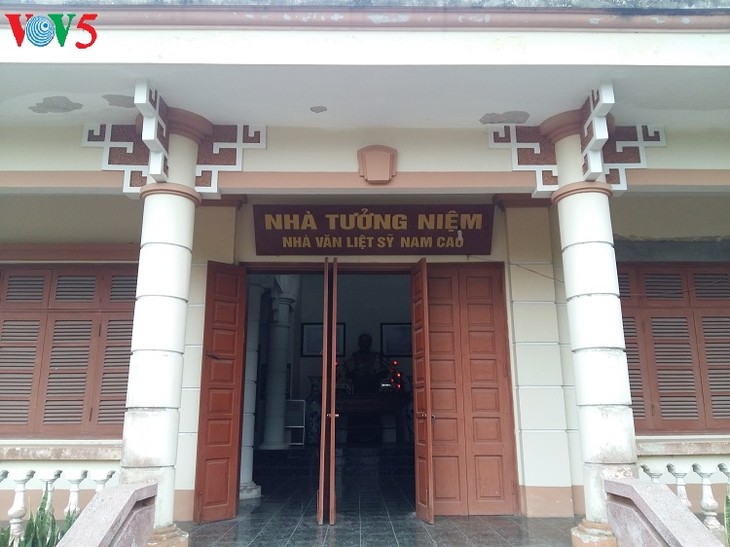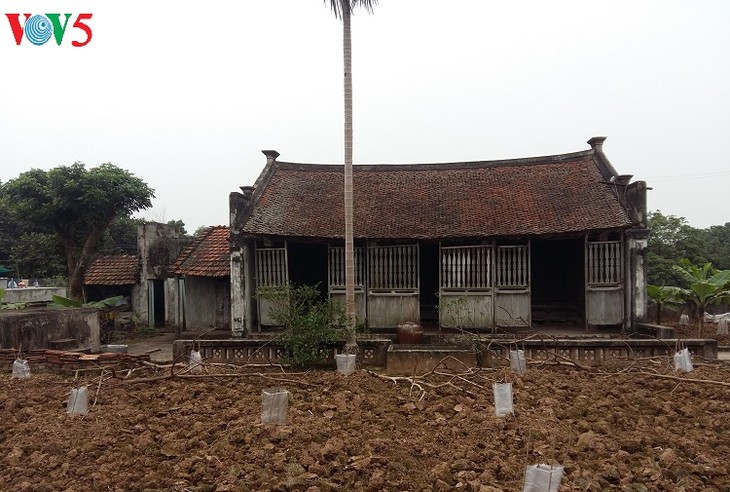(VOVWORLD) - Vu Dai (or Dai Hoang) village in Hoa Hau commune, Ha Nam province, about 100km from Hanoi, is famous for its braised fish, king bananas, and textiles. It is the home of martyr and writer of Vietnamese realism Nam Cao.
 The memorial house honoring writer and martyr Nam Cao. (Photo: Ngoc Anh) The memorial house honoring writer and martyr Nam Cao. (Photo: Ngoc Anh) |
Vu Dai village is closely associated with Nam Cao’s classic short story “Chi Pheo”, about northern farmers during Vietnam’s colonial-feudal period.
The village is also featured in a well-known Vietnamese film called "Vu Dai Village in the old days", considered one of the classics of 20th-century Vietnamese cinematography. The film was produced in 1982 by director and People’s Artist Pham Van Khoa. Along with the film “Chi Dau” (Ms. Dau), produced in 1980 by the same director, "Vu Dai Village in the old days" is one of the few Vietnamese movies to achieve great public success. They depict rural life in northern Vietnam prior to the 1945 August Revolution.
Nam Cao, whose real name is Tran Huu Tri, was born in 1917 and died in 1951. He is one of the exemplary Vietnamese literary figures, an icon of the Vietnamese realism of the 20th century. He was posthumously awarded Vietnam’s French Resistance Medal First-class and the Ho Chi Minh Prize for Literature and Arts in 1996.
Vu Dai villager Tran Thi Ngan said: “I’m proud to live in the hometown of writer and martyr Nam Cao. Hoa Hau is a heroic commune. He has always inspired us to uphold our heroic tradition.”
Nam Cao’s writing is profound, subtle, and full of sympathy for poor people. In 10 years, he wrote an impressive volume of work, including “Chi Pheo”, “Old Man Hac”, “Redundant Life”, and “Teacher Thu”.
A house memorializing Nam Cao was inaugurated in November, 2004, in his hometown.
Tran Chien Binh of Nhan Tien commune, Ha Nam province, said: “We are very moved to visit Nam Cao’s grave. He was one of the greatest writers of our country, leaving for later generations a large body of work that includes his immortal story “Chi Pheo”. It’s a tragedy that he died so early. We want to learn from his patriotism.”
 Ba Kien’s house. (Photo: Ngoc Anh) Ba Kien’s house. (Photo: Ngoc Anh) |
Not far from the Nam Cao memorial house stands “Ba Kien’s house”, managed by the Culture-Information Section of Lý Nhân District. Tyrant landlord Ba Kien is a character in the widely popular short story “Chi Pheo”, who was modeled after Nghi Binh, a real landlord in the Vietnamese feudal period. Village elder Tran Ba Luan told VOV: “When you visit Vu Dai village, you can’t miss the memorial house of writer and martyr Nam Cao. Crowds of domestic and foreign visitors come to the village each year to burn incense to him. I recount for visitors what I have been told by contemporaries of Nam Cao about the village and his life. Nam Cao was named after a street in Hanoi. Young villagers join an annual movement to follow Nam Cao’s example and do good deeds for his family.”
Every year on the 30th day of the 10th lunar month, Vu Dai villagers hold a ceremony to mark the death anniversary of martyr and writer Nam Cao.